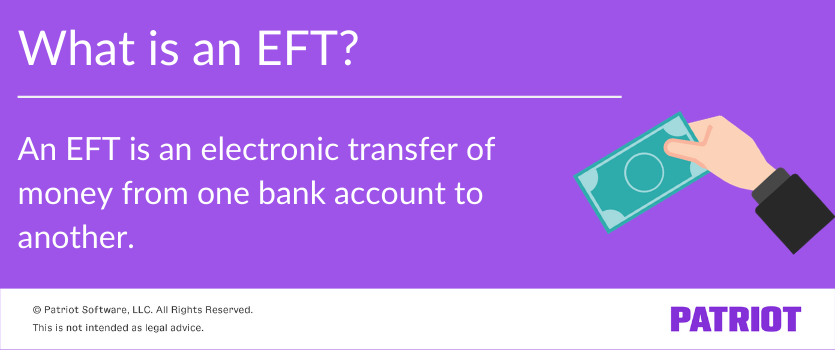As a business owner, you’re likely always on the hunt for ways to save time and money. Maybe you use basic accounting software to track incoming and outgoing money. Or, maybe you automate your email marketing with a tool that sends emails to your customers or vendors for you.
If you love saving time and money, an electronic funds transfer process (EFT) may be a good fit for you. Read on to learn how EFTs can benefit your small business.
What is an electronic funds transfer?
Before we go further into the world of EFTs, you need to learn what they are. So, what is electronic fund transfer?
An EFT is an electronic transfer of money from one bank account to another. You can send EFTs within one or multiple banking institutions (e.g., direct deposit ACH). An EFT transaction is done electronically over a computerized network.
An electronic funds transfer can include things like:
- Direct deposit payments
- Debit or credit card transactions
- Instant payments
- Online bill payments
- Wire transfers
- ATMs
- Electronic checks
Using EFT for banking can reduce the amount of time and money you spend paying expenses and receiving income. You can make or receive payments via EFT within hours or even minutes, making EFT payments convenient for both buyers and sellers.
With EFT, you can avoid the hassle of distributing paper checks or cash because everything is paperless.
One caveat to an electronic funds transfer is that you must make sure you have adequate funds in your account to cover automated payments. If you don’t have sufficient funds in your account and an EFT is attempted, you may need to pay a non-sufficient funds fee.

EFT examples
To see EFTs in action, check out a couple of examples below.
Example 1
Say you use your business credit card to make a purchase at a store. Your transaction is processed through an EFT system and allows an immediate payment to the store and a deduction from your business bank account.
Example 2
Let’s say you set up direct deposit so you can pay your employees electronically. Because direct deposits are a form of EFT, funds are collected from your business bank account and transferred to your employees’ bank accounts.
Want to impress your friends at a dinner party?
Get the latest accounting news delivered straight to your inbox.
EFT vs. ACH payments
If you’re a business owner, you’ve probably also heard of ACH (automated clearing house) payments.
Many people think that EFT and ACH payments are the same. Although they’re similar and are both forms of electronic payments, ACH and EFT payments are not one and the same.
An ACH payment is actually a form of an EFT payment. ACH payments occur when money moves from one bank to another bank. With ACH payments, the money is processed through the Automated Clearing House Network. The ACH system is run by the National Automated Clearing House Association (NACHA).
Like ACH payments, EFT payments are also processed through the Automated Clearing House network.
Check out how EFT and ACH payments compare and contrast below:
| EFT Payments | ACH Payments |
|---|---|
| Electronic transfer of money from one bank account to another | Transfer of money between two financial institutions electronically |
| Processed through the ACH network | Processed through the ACH network |
| Quicker than ACH payments | Slower than EFT payments |
| Can be used for multiple types of payments (including ACH) | Typically only used for direct deposits and direct payments |
Perks of an electronic funds transfer process
Now that you know some background information about EFT, it’s time to learn how these types of payments can benefit your small business. Take a look at four perks of having an electronic funds transfer process below.
1. Convenient
An electronic money transfer is a convenient and secure way to transfer funds. Not only is the process easy, but it’s also a quick option for busy business owners and other professionals.
With an EFT, much-needed payments can be paid quickly before deadlines, making it a convenient option for buyers, sellers, and small business owners.
2. Quick
Generally, EFTs are a quick and painless process. The amount of time needed to process an EFT payment depends on a few factors, including:
- Your EFT provider
- Type of payment
- When you submit payment
EFTs are generally fast, making it a good option for business owners. EFT payments typically take anywhere from one to four days to process and clear. In most cases, EFT payments only process on business days (Monday through Friday).
Keep in mind that there are typically cutoff times for EFTs. Check with your bank for more information on EFT deadlines and transaction cutoff times.
3. Paperless
As mentioned, EFT payments are 100% electronic. Therefore, there’s no need for paper.
With EFT payments, you can ditch the paper and process payments electronically. Not to mention, you can avoid spending additional money on supplies like check stock, ink, and envelopes.
4. Costs
If you’re looking to save money, EFT payments can be a good alternative to other types of payment methods.
Depending on the type of transaction and the banking institution, EFT payments might have a small fee (e.g., ATM fees). And, some transactions might be completely free.
Talk to your banking institution about setting up EFT payments and incurring fees.
Keep track of your electronic payments by recording them in Patriot’s easy-to-use accounting software. See a full picture of your business’s financial health, track incoming and outgoing money, and more. Start your free trial today!
This article has been updated from its original publication date of March 13, 2012.
This is not intended as legal advice; for more information, please click here.






